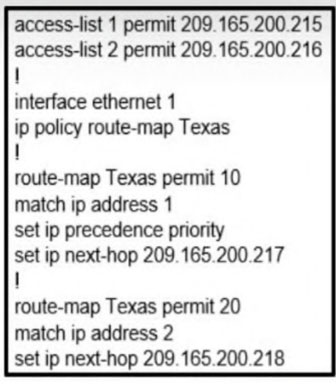
Refer to the exhibit. Packets arriving from source 209.165.200.215 must be sent with the precedence bit set to 1, and packets arriving from source
209.165.200.216 must be sent with the precedence bit set to 5. Which action resolves the issue?

Refer to the exhibit. Packets arriving from source 209.165.200.215 must be sent with the precedence bit set to 1, and packets arriving from source
209.165.200.216 must be sent with the precedence bit set to 5. Which action resolves the issue?
To resolve the issue, the `set ip precedence` command should classify packets accurately based on the required precedence bits. In this scenario, precedence bit 1 corresponds to 'priority,' and precedence bit 5 corresponds to 'critical.' The existing configuration already uses `set ip precedence priority` in the route-map for packets from source 209.165.200.215 (matching access-list 1), correctly setting the precedence bit to 1. For packets arriving from source 209.165.200.216 (matching access-list 2), adjusting the route-map to `set ip precedence critical` will set the precedence bit to 5, which is appropriate based on the requirements. Thus, the correct action is to use `set ip precedence critical in route-map Texas permit 20`.
Answer is correct IP Precedence 000 (0) Routine or Best Effort 001 (1) Priority 010 (2) Immediate 011 (3) Flash - mainly used for Voice Signaling or for Video. 100 (4) Flash Override 101 (5) Critical -mainly used for Voice RTP. 110 (6) Internet 111 (7) Network
Ans is correct https://www.ccexpert.us/ccie/setting-ip-precedence.html
route-map Texas permit 10 match ip address 1 set ip precedence priority --> bit set to 1 implies priority set ip next hop x.x.x.x !! route-map Texas permit 20 match ip address 2 ---------- --> bit set to 5 implies critical (set ip precedence critical) set ip next hop x.x.x.x
A is corerct